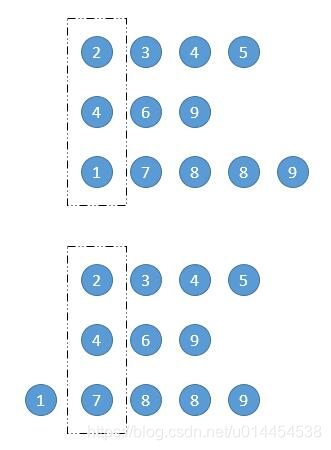- 记录于2019年5月22日
20. 有效的括号
① 题目描述
- 给定一个只包括 ‘(’,’)’,’{’,’}’,’[’,’]’ 的字符串,判断字符串是否有效。
- 有效字符串需满足:
左括号必须用相同类型的右括号闭合。
左括号必须以正确的顺序闭合。
注意空字符串可被认为是有效字符串。 - 示例 1:
输入: “()”
输出: true
- 示例 2:
输入: “()[]{}”
输出: true
- 示例 3:
输入: “(]”
输出: false
- 示例 4:
输入: “([)]”
输出: false
- 示例 5:
输入: “{[]}”
输出: true
② 使用堆栈(Stack)
- 括号配对问题,典型的方法——使用
stack。当stack为empty时,将括号压入stack;当栈顶和当前待扫描括号配对时,弹出栈顶的括号;如果都不满足直接压入stack,比如({[。 - 时间复杂度:
O(n),因为我们一次只遍历给定的字符串中的一个字符并在栈上进行O(1)的推入和弹出操作。 - 空间复杂度:
O(n),当我们将所有的开括号都推到栈上时以及在最糟糕的情况下,我们最终要把所有括号推到栈上。例如((((((((((。 - 代码如下:
public boolean isValid(String s) {
int len = s.length();
if (len == 0) {
return true;
}
if (len % 2 != 0) {
return false;
}
Stack<Character> stack = new Stack<>();
for (int i = 0; i < len; i++) {
if (stack.isEmpty()) {
stack.push(s.charAt(i));
} else {
if (stack.peek() == '(' && s.charAt(i) == ')') {
stack.pop();
} else if (stack.peek() == '[' && s.charAt(i) == ']') {
stack.pop();
} else if (stack.peek() == '{' && s.charAt(i) == '}') {
stack.pop();
} else {
stack.push(s.charAt(i));
}
}
}
if (stack.isEmpty()) {
return true;
}
return false;
}
21. 合并两个有序链表
① 题目描述
- 将两个有序链表合并为一个新的有序链表并返回。新链表是通过拼接给定的两个链表的所有节点组成的。
- 示例:
输入:1->2->4, 1->3->4
输出:1->1->2->3->4->4
② 借助新的链表头
- 通过比较
l1和l2的val,决定是将l1加入新的链表,还是将l2加入新的链表,并且更新l1或l2的指针。 - 注意特殊情况:
①l1或l2为null,直接返回另一条链表;
② 完成合并后,总有一条链表不在末尾,直接将其加入新的链表即可。
public ListNode mergeTwoLists(ListNode l1, ListNode l2) {
//可以提前判断,也可以不用判断
if (l1 == null) {
return l2;
}
if (l2 == null) {
return l1;
}
ListNode result = new ListNode(0);
ListNode cur = result;
while (l1 != null && l2 != null) {
if (l1.val < l2.val) {
cur.next = l1;
l1 = l1.next;
} else {
cur.next = l2;
l2 = l2.next;
}
cur = cur.next;
}
if (l1 != null) {
cur.next = l1;
} else {
cur.next = l2;
}
return result.next;
}
22. 括号生成
① 题目描述
- 给出 n 代表生成括号的对数,请你写出一个函数,使其能够生成所有可能的并且有效的括号组合。
- 例如,给出 n = 3,生成结果为:
[
"((()))",
"(()())",
"(())()",
"()(())",
"()()()"
]
② 回溯法
public List<String> generateParenthesis(int n) {
List<String> result = new ArrayList<>();
if (n == 0) {
return result;
}
helper(result, "", 0, 0, n);
return result;
}
public void helper(List<String> result, String s, int open, int close, int n) {
if (s.length() == n * 2) {
result.add(s);
return;
}
if (open < n) {
helper(result, s + "(", open + 1, close, n);
}
if (open > close) {
helper(result, s + ")", open, close + 1, n);
}
}
③ 暴力法
public List<String> generateParenthesis(int n) {
List<String> result = new ArrayList<>();
if (n == 0) {
return result;
}
helper(result, "", n);
return result;
}
public void helper(List<String> result, String s, int n) {
if (s.length() == n * 2) {
if (isTrue(s)) {
result.add(s);
}
return;
}
helper(result, s + "(", n);
helper(result, s + ")", n);
}
public boolean isTrue(String s) {
int count = 0;
for (int i = 0; i < s.length(); i++) {
if (s.charAt(i) == '(') {
count++;
} else {
count--;
}
if (count < 0) {
return false;
}
}
return count == 0;
}
23. 合并K个排序链表
① 题目描述
- 合并 k 个排序链表,返回合并后的排序链表。请分析和描述算法的复杂度。
- 示例:
输入: [
1->4->5,1->3->4,2->6]
输出:1->1->2->3->4->4->5->6
② 自己的笨办法
- 先获取所有排序链表的节点值,重新排序后将其存入新的链表中。
- 巧用
List和Collections.sort(),实现快速从新排序。 - 代码如下:
public ListNode mergeKLists(ListNode[] lists) {
ListNode result = new ListNode(0);
ListNode cur = reuslt;
if (lists.length == 1) {
return lists[0];
}
List<Integer> arr = new ArrayList<>();
for (int i = 0; i < lists.length; i++) {
ListNode p = lists[i];
while (p != null) {
arr.add(p.val);
p = p.next;
}
}
Collections.sort(arr);
for (int i = 0; i < arr.size(); i++) {
ListNode node = new ListNode(arr.get(i));
cur.next = node;
cur = cur.next;
}
cur.next = null;
return result.next;
}
③ 一列一列的比较(效果好像比自己的笨办法差很多)
- 将所有的链表对齐,一列一列的查找当前列的最小值,直到所有链表均为null。
- 示意图如下:

- 代码如下:
public ListNode mergeKLists(ListNode[] lists) {
ListNode result = new ListNode(0);
ListNode cur = reuslt;
if (lists.length == 1) {
return lists[0];
}
while (true) {
int min = Integer.MAX_VALUE;
int min_index = 0;
boolean flag = true;
for (int i = 0; i < lists.length; i++) {
if (lists[i] != null) {
if (lists[i].val < min) {
min = lists[i].val;
min_index = i;
}
flag = false;
}
}
if (flag) {
break;
}
cur.next = lists[min_index];
cur = cur.next;
lists[min_index] = lists[min_index].next;
}
cur.next = null;
return result.next;
}
④ 使用优先队列(掌握优先队列的定义)
- 通过自定义比较器,实现针对
ListNode的优先队列。整体思想与一列一列的比较一样的,只是将比较过程交给了优先队列自己完成。
Queue<ListNode> q = new PriorityQueue<ListNode>(cmp);
- 注意链表的特殊性,看起来队列中存储的是一个节点,其实他存储的是整条链表。
- 初始化优先队列时,一定不要忘记判断
lists[i]是否为null!
Comparator<ListNode> cmp = new Comparator<ListNode>() {
// 自定义比较器
@Override
public int compare(ListNode o1, ListNode o2) {
return o1.val - o2.val;
}
};
public ListNode mergeKLists(ListNode[] lists) {
ListNode result = new ListNode(0);
ListNode cur = result;
if (lists.length == 1) {
return lists[0];
}
//建立队列,每个位置存储一个链表
Queue<ListNode> q = new PriorityQueue<ListNode>(cmp);
for (int i = 0; i < lists.length; i++) {
if (lists[i] != null) {
q.add(lists[i]);
}
}
while (!q.isEmpty()) {
cur.next = q.poll(); // cur.next指向满足条件的待合并节点
cur = cur.next; // 更新cur指针,指向最新节点,这时整个链表与弹出的链表是一个整体
if (cur.next != null) {
// 如果cur.next不为空,将剩余的链表重新加入优先队列
q.add(cur.next);
}
}
cur.next = null;
return result.next;
}